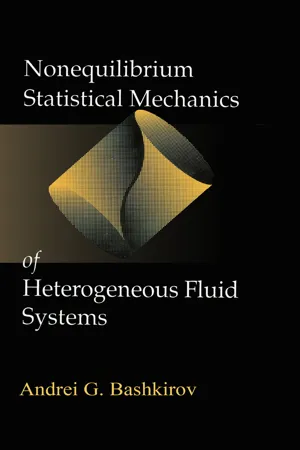
This is a test
- 176 pages
- English
- ePUB (mobile friendly)
- Available on iOS & Android
eBook - ePub
Nonequilibrium Statistical Mechanics of Heterogeneous Fluid Systems
Book details
Book preview
Table of contents
Citations
About This Book
There is a wide variety of heterogeneous fluid systems that possess interphase surfaces. This monograph is devoted to pioneering studies in nonequilibrium statistical mechanics of such systems. Starting from the Liouville equation, the equations of surface hydrodynamics are derived with allowance for discontinuities of thermodynamic parameters of interphase boundaries. Brownian motion of a large solid particle in a fluid and nucleation are treated as results of fluctuations of flows across particle surfaces. With the use of the Gibbs method, a shock wave in a gas is considered as a sort of an interphase surface, and the surface tension of a shock front is introduced for the first time.
Frequently asked questions
At the moment all of our mobile-responsive ePub books are available to download via the app. Most of our PDFs are also available to download and we're working on making the final remaining ones downloadable now. Learn more here.
Both plans give you full access to the library and all of Perlego’s features. The only differences are the price and subscription period: With the annual plan you’ll save around 30% compared to 12 months on the monthly plan.
We are an online textbook subscription service, where you can get access to an entire online library for less than the price of a single book per month. With over 1 million books across 1000+ topics, we’ve got you covered! Learn more here.
Look out for the read-aloud symbol on your next book to see if you can listen to it. The read-aloud tool reads text aloud for you, highlighting the text as it is being read. You can pause it, speed it up and slow it down. Learn more here.
Yes, you can access Nonequilibrium Statistical Mechanics of Heterogeneous Fluid Systems by Andrei G. Bashkirov in PDF and/or ePUB format, as well as other popular books in Physical Sciences & Physics. We have over one million books available in our catalogue for you to explore.
Chapter 1
Zubarev Method of Nonequilibrium Statistical Operator
1.1 Contracted Description of a Statistical System
The main mission of nonequilibrium statistical mechanics is to derive equations describing irreversible processes, starting from the Liouville equation for the distribution function in the phase space of the system. It is known, that this equation is reversible relative to time inversion, in other words, say this equation is invariant relative to simultaneous changes of the time direction and the signs of all particle velocities (or momenta).
To obtain equations describing irreversible processes, it is necessary to proceed to a less detailed description of the system. It is the Bogoliubov concept of the hierarchy of relaxation times at the evolution of a nonequilibrium statistical system that is of first importance in a mathematical formulation of this less detailed or contracted description.
The Bogoliubov concept [1] in its original application to moderately dense gases is as follows: to describe an N–particle system at any arbitrary initial state we are to assign a full N–particle distribution function or a rich variety of many–particle time–dependent distribution functions. However, after a short “time of synchronization” occurs, time dependence of distribution functions becomes fully determined by the evolution of a one–particle distribution function. As a result, after some characteristic time, we have a simplification or a contraction of the description and as a consequence it is possible to describe the further evolution of the N–particle system with the use of fewer parameters. In the case of a dilute gas we use the one–particle distribution function. Thus, there is a kinetic stage of evolution.
Later, after a next characteristic time, the next contraction of the system description occurs, using fewer parameters. For a dilute gas there are some first momenta of the one–particle distribution function, for example, the density, the temperature, and the mean velocity of gas as functions of the time and space coordinates. So we have a hydrodynamic stage of evolution.
For moderately dense gases, the time of synchronization of many...
Table of contents
- Cover
- Title Page
- Copyright Page
- Dedication
- Preface
- Contents
- 1 Zubarev Method of Nonequilibrium Statistical Operator
- 2 Transport Phenomena at Interfaces and the Problem of Boundary Conditions in Hydrodynamics
- 3 Shock Waves in Gases as Interface Surfaces
- 4 Nucleation Theory: Fluctuations of Diffusion Flow across the Interphase Boundary
- 5 Brownian Motion: Momentum Flow Fluctuations on Interphase Boundary
- 6 Brownian Motion of N Spheres in Inhomogeneous Fluids
- A Vector and Tensor Divergencies in Curvilinear Coordinates
- B Mechanical Definition of Surface Tension
- C Exclusion of Time-Derivatives of Parameters
- Bibliography
- Index